Creative Potato Dishes: Elevate Your Cooking

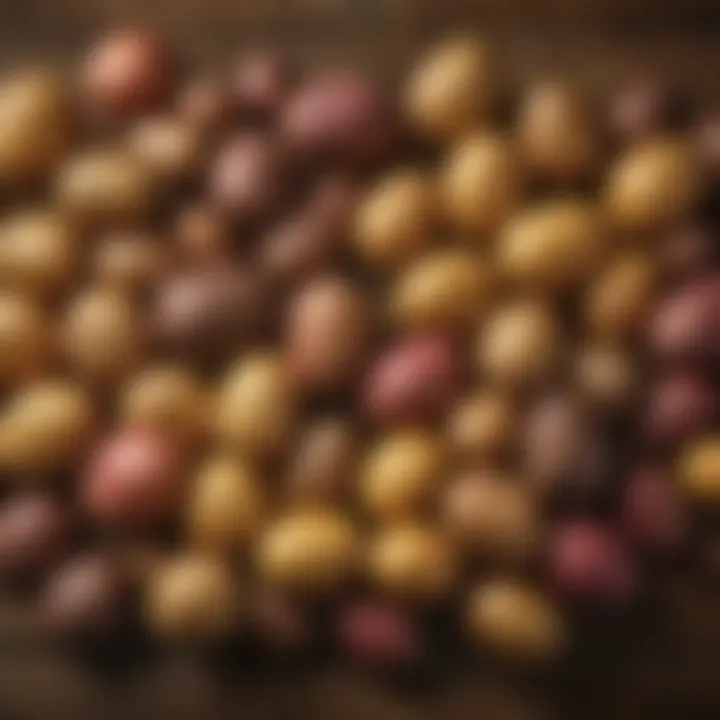
Recipe Highlight
One standout dish that showcases the versatile nature of potatoes is the Loaded Baked Potato Casserole. This hearty recipe transforms the humble potato into a comforting meal that can easily please a crowd.
Essential Ingredients:
- 4 large russet potatoes
- 1 cup sour cream
- 1 cup shredded cheddar cheese
- 1/2 cup cooked and crumbled bacon
- 1/4 cup chopped green onions
- Salt and pepper to taste
Estimated Preparation Time: 1 hour
Servings: 6
Step-by-Step Instructions
- Preheat your oven to 400°F (200°C).
- Wash and roast the potatoes: Prick each potato with a fork and bake in the preheated oven for about 45 minutes or until tender.
- Prepare the filling: Once the potatoes are cool enough to handle, cut them in half and scoop out the flesh into a large bowl.
- Combine ingredients: Mix the potato flesh with sour cream, half of the cheddar cheese, bacon, green onions, salt, and pepper. Mix well until smooth.
- Fill the potato skins: Place the potato skins back onto a baking sheet and fill them generously with the potato mixture.
- Top with cheese: Sprinkle the remaining shredded cheese on top of the filled skins.
- Bake again: Return the loaded skins to the oven for an additional 15-20 minutes, or until the cheese is melted and bubbly.
- Serve hot: Garnish with more green onions if desired and serve warm.
This recipe combines the beloved crunch of bacon with creamy potatoes, elevating a simple ingredient into something extraordinary.
Variations and Substitutions
- Cheese Options: For a different flavor profile, consider using pepper jack cheese or feta cheese instead of cheddar.
- Vegetarian Version: Omit the bacon and add sautéed mushrooms or spinach for a meatless option.
- Extra Flavor: Add garlic powder or paprika to the potato mixture for an additional kick.
Time-Saving Cooking Tips
- Pre-peeled Potatoes: Look for pre-peeled and cut potatoes at the grocery store to save prep time.
- Batch Cooking: Consider making a double batch of the casserole and freezing half for a quick meal later in the week.
- Use a Potato Ricer: A ricer can make the mashed potato filling smoother and fluffier, improving your dish's texture.
Nutritional Information
- Calories per serving: Approximately 368 calories
- Key Nutrients: Each serving provides about 12g of protein, 5g of fiber, and is a good source of potassium and vitamin C.
- Diet Suitability: This dish can be adjusted to meet various dietary needs by using low-fat sour cream and cheese to reduce calories. It can also be made gluten-free with careful ingredient selection.
Prelims to Potatoes
Potatoes hold a significant place in global cuisine. They are not just a side dish; they are a fundamental component in many diets. Understanding the importance of potatoes helps in recognizing their versatility in cooking. This section will explore various aspects of potatoes that contribute to their widespread acceptance and usage in different culinary traditions.
Potatoes are a key ingredient that can transform meals. Their ability to adapt to various flavors and cooking methods makes them indispensable in both home kitchens and professional gastronomy. This introduction will lay the groundwork for the exploration of numerous potato dishes, their preparation methods, and nutritional benefits.
Overview of Potatoes as a Staple Food
Potatoes are often referred to as a staple food across many cultures. They are rich in carbohydrates, providing essential energy for daily activities. Furthermore, potatoes are versatile; they can be cooked in numerous ways. This includes boiling, baking, frying, or mashing.
Their nutritional profile makes them appealing. With high levels of potassium, vitamin C, and dietary fiber, they contribute positively to health. However, preparation methods can affect their nutritional value. For instance, frying potatoes may add unhealthy fats, while baking or steaming retains their natural benefits.
Varieties of Potatoes
The variety of potatoes available today is extensive. Each type offers unique characteristics which influence their usage in cooking.
Common Types
Common types of potatoes include Russet, Yukon Gold, and Red potatoes. These varieties are widely known and available in most markets. Russet potatoes are often favored for their high starch content, making them ideal for baking and frying. They have a fluffy texture when cooked.
On the other hand, Yukon Gold potatoes feature a creamy consistency and are excellent for mashing or roasting. Red potatoes are waxy and hold their shape well, making them suitable for salads and soups. Their colors and textures contribute to a diverse cooking experience.
Regional Varieties
Regional varieties of potatoes offer flavors and textures influenced by their growing conditions. For example, Fingerling potatoes are known for their elongated shape and often have a nutty flavor. These potatoes are often used in gourmet cooking.
Another variant is the Purple potato, which is not just visually striking but also packed with antioxidants. Their unique appearance can enhance a dish's presentation. Understanding regional varieties allows cooks to experiment with different flavors and textures, broadening culinary possibilities.
Specialty Potatoes
Specialty potatoes, such as Sweet potatoes and Peruvian Purple potatoes, have gained popularity. Sweet potatoes are not true potatoes but are often included in discussions due to their similarities and versatility. They have a higher sugar content, providing sweetness and a vibrant color.
Peruvian Purple potatoes are known for their bold color and rich taste profile. They offer a range of antioxidants and are often used in traditional South American dishes. Specialty potatoes allow for creative recipes that stand out in flavor and presentation. Incorporating these unique varieties enhances any culinary exploration of potatoes.
Classic Potato Dishes
Classic potato dishes represent a significant portion of global cuisine. These meals are essential for their familiar flavors and comforting textures. They can be found in numerous cultures, often serving as central items in family gatherings and special occasions. The versatility of potatoes allows them to pair with various ingredients effectively, making them a staple in any kitchen. In this section, we delve into some of the most recognized potato dishes and their appeal to cooks of different skill levels.
Mashed Potatoes
Basic Preparation
The preparation of mashed potatoes is a fundamental skill in cooking. To make basic mashed potatoes, you typically start by peeling and cubing potatoes, then boiling them until tender. After draining, they are mashed with milk and butter until creamy. This simplicity makes it an essential dish for both novice and seasoned cooks. Mashed potatoes are a canvas for flavor, making them a beloved choice in many households. However, if not prepared correctly, they can become gluey if over-mixed.
Flavor Variations
Exploring flavor variations of mashed potatoes can elevate this classic side dish. Adding garlic, cheese, or herbs can introduce subtle complexities to the flavor profile. These variations allow for seasonal and regional adaptations, appealing to diverse tastes. However, it is important to strike a balance; overwhelming the basic potato can detract from its natural flavor.
Serving Suggestions
Mashed potatoes serve well as a side dish, complementing meats and vegetables alike. They can be served plain or dressed up with gravy or chives. This adaptability makes them a popular choice for meal planning. Their creamy texture contrasts nicely with crispy items, providing a satisfying culinary experience. On the downside, they can require careful timing to ensure they are served at the right temperature alongside other dishes.
Baked Potato
Traditional Toppings
Traditional toppings for baked potatoes often include butter, sour cream, cheese, chives, and bacon bits. Each topping adds texture and richness to the potato's fluffy interior. The popularity of baked potatoes in casual dining is notable, as they provide a hearty base that pairs well with various toppings. One challenge is that too many toppings can lead to an overpowering taste, making it essential to choose wisely.
Alternative Fillings
Alternative fillings for baked potatoes can range from chili to steamed vegetables. These creative options can turn a simple baked potato into a meal on its own. They are also beneficial for accommodating different dietary preferences. However, the challenge lies in ensuring that the fillings are not too watery, as this can make the potato soggy.
Cooking Techniques
Various cooking techniques exist for preparing baked potatoes, including conventional oven, microwave, or grill. Each method provides a different result in flavor and texture. Baking traditionally delivers a crispy skin, while microwaving is faster but may lack that appealing texture. Understanding these techniques will contribute to a well-executed baked potato.
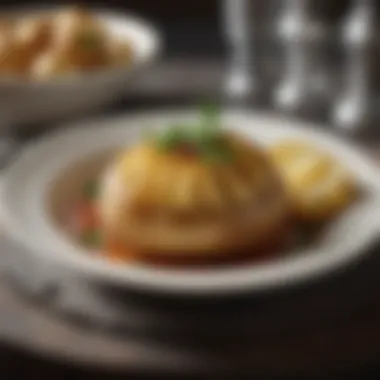
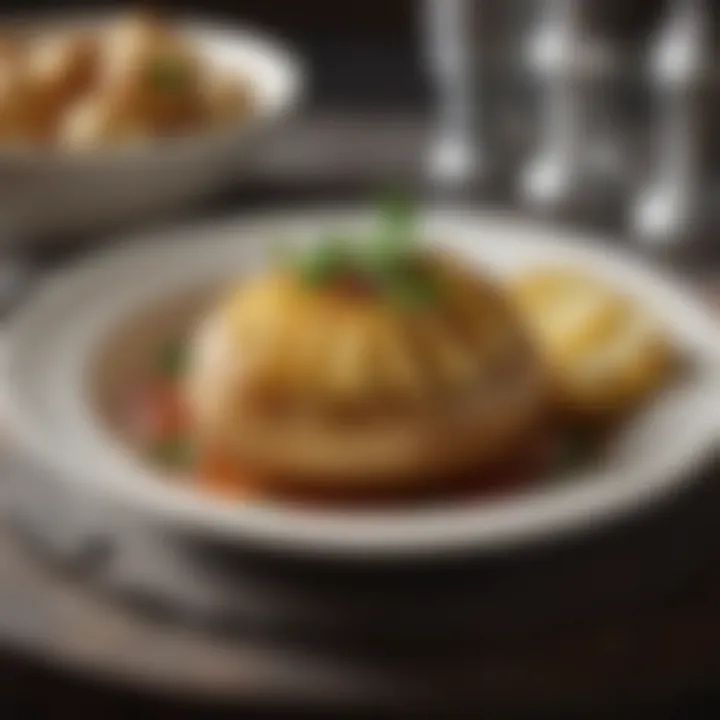
French Fries
Methods of Preparation
French fries can be prepared in several ways, including deep frying, baking, or air frying. Each method impacts the crispiness and texture of the fries, making it a central consideration in recipe development. The appeal of homemade fries lies in their ability to be tailored to personal preferences. However, deep frying can result in excess oiliness, while baking may yield less crispy results.
Dipping Sauces
Dipping sauces enhance the experience of eating French fries. Common options like ketchup, mayonnaise, or aioli offer a balance of flavors that can complement the fries perfectly. This added dimension can appeal to different taste preferences, making fries even more enjoyable. However, it is essential to select sauces that do not overwhelm the basic flavor of the fries.
Healthier Alternatives
Healthier alternatives to traditional French fries include baked sweet potato fries or zucchini fries. These substitutes offer lower-calorie options while retaining enjoyable flavors. They appeal especially to health-conscious individuals but may lack the satisfying texture of classic fries. It's important for cooks to consider both health benefits and taste when exploring alternatives.
Potato-Based Comfort Foods
Potato-based comfort foods stand out as a significant category in the culinary exploration of potatoes. These dishes are not only pleasing to the palate but often evoke a sense of nostalgia and warmth. Their versatility allows for various adaptations, catering to different dietary needs and preferences. It’s essential to highlight that comfort foods often provide reassurance during hectic times. Their heartiness makes them ideal for family gatherings or cozy dinners. In this article, we dive into three popular varieties: potato soup variations, casseroles, and salads. Each section presents unique opportunities for creativity while utilizing the humble potato.
Potato Soup Variations
Creamy Soups
Creamy potato soups are celebrated for their satisfying texture and rich flavors. This type of soup tends to blend potatoes with cream or milk, producing a velvety finish that many find appealing. One prominent characteristic of creamy soups is their adaptability; they can incorporate various herbs and spices for enhanced taste. This makes them a preferred choice for individuals seeking comfort in a bowl, especially during colder months. The creamy consistency can be a double-edged sword, though. While it promises indulgence, it can also lead to higher calorie content if not balanced wisely. Despite this, the warmth and taste of a creamy potato soup often outweighs immediate health considerations for many cooks.
Chunky Soups
Chunky potato soups offer a different textural experience. They maintain the potato's shape, resulting in a more rustic presentation. This variety capitalizes on the blending of ingredients like vegetables or bacon alongside the potatoes, giving it a hearty profile. A key characteristic of chunky soups is their ability to be filling while remaining light on the palate. This offers a beneficial option for people looking to enjoy a nutrient-rich meal without feeling too heavy. However, some may find it less comforting than its creamy counterpart, especially those favoring smooth textures.
Vegan Options
Vegan potato soups are gaining popularity as more individuals adopt plant-based diets. These soups utilize plant-based alternatives to achieve creaminess, primarily using ingredients like almond milk or coconut cream. A core advantage of vegan options is their ability to cater to a broader audience, including those with lactose intolerance. They can provide the same warmth and satisfaction without compromising on flavor. While they may require some creativity in seasoning, the results can be quite rewarding, creating a dish that resonates with many.
Potato Casseroles
Types of Casseroles
Potato casseroles encompass a range of dishes that combine potatoes with various ingredients. The types vary from classic scalloped or gratin to more inventive options that include vegetables or proteins. A notable characteristic of casseroles lies in their ability to serve multiple people easily, making them a beneficial choice for families or dinner parties. The comfort factor is high, as many find casseroles remind them of home-cooked meals. The unique feature of casseroles is their flexibility; they can be prepared ahead of time and baked when needed. However, some may consider them time-consuming due to the layering involved.
Cooking Methods
Cooking methods for potato casseroles can include baking, boiling, or even slow cooking. Baking is the classic way that achieves a crispy top, which adds to the dish's appealing texture. A key advantage of this method is the enhancement of flavors through caramelization. Each cooking method brings a different profile to the dish, allowing cooks to choose based on time and equipment at hand. However, some might find bakes take a long time, which may not be practical for every cook.
Freezer-Friendly Versions
Freezer-friendly casseroles are a lifesaver for meal prep enthusiasts. They can be made in batches and frozen for future meals without significant loss of flavor or texture. The essence of these versions lies in convenience; they allow for quick meals on busy days. A core feature is their ability to be reheated efficiently, making them ideal for those with dynamic schedules. While not every casserole type freezes well, many like shepherd's pies or cheesy potatoes maintain their quality. However, some ingredients may not freeze well, so careful planning is needed.
Potato Salads
Classic Recipes
Classic potato salad represents a timeless dish often featured at picnics and gatherings. The traditional recipes typically include boiled potatoes, mayonnaise, and various seasonings. This simplicity contributes significantly to its popularity. One key characteristic is its versatility; it can be customized with ingredients like pickles, eggs, or herbs to suit different preferences. However, classic potato salad can be quite calorie-dense, making it a less favorable choice for health-conscious individuals.
Regional Twists
Regional twists on potato salad provide an exciting way to explore cultural flavors. Variations can involve different dressings or add-ins based on regional preferences. For instance, German potato salad incorporates vinegar and bacon, creating a tangy twist. This type's diversity reflects local tastes and traditions, offering a unique dining experience. While regional versions can be adaptations, they often retain the comforting essence of the original dish, appealing to adventurous eaters. Some may find it daunting to switch from conventional recipes, which could limit their willingness to explore these flavors.
Health-Conscious Alternatives
Health-conscious alternatives to traditional potato salads focus on lighter ingredients. Utilizing Greek yogurt instead of mayonnaise is a popular choice that reduces fat while maintaining creaminess. Another aspect could include increasing vegetable content for added nutrients. A core characteristic is their appeal to modern dietary trends, making them more relevant to today's health-focused audience. However, the effort to create a lighter version requires careful balancing of flavors to avoid losing the satisfying base that makes potato salad enjoyable.
Innovative Uses for Potatoes
Potatoes are not just simple side dishes; they have tremendous potential in innovative culinary applications. Exploring creative ways to use this versatile vegetable adds depth to any meal. In this section, we will examine several novel uses for potatoes and their significance in contemporary cuisine. From comforting gnocchi to crispy pancakes and delightful snacks, potatoes can redefine the culinary experience.
Potato Gnocchi
Basic Recipe
To make potato gnocchi, begin with high-starch potatoes, like Russets or Yukon Golds. Boil the potatoes until fork-tender, then peel and mash them while hot. Combine the mashed potatoes with flour and an egg, kneading to form a dough. The key characteristic of this basic recipe is its relative simplicity while retaining a delightful flavor. This makes it a popular choice among home cooks.
Advantages of this recipe include:
- Ease of preparation: Just a few ingredients are needed.
- Versatility: Gnocchi can be served with various sauces.
However, be cautious about overworking the dough, as it can lead to dense results. Light handling is crucial for achieving the perfect texture.
Serving Suggestions
When serving potato gnocchi, consider enhancing the dining experience with various sauces. Contemporary options include pesto or browned butter with sage. Highlighting the adaptability of gnocchi is its ability to pair seamlessly with a multitude of flavors. This characteristic makes it a favored option in diverse culinary settings.
Key characteristics include:
- Flexibility: Can match various toppings and sauces.
- Appeal: The dish often attracts a wide range of diners, appealing to both children and adults.
Do keep in mind; some sauces may overpower the delicacy of the gnocchi itself.
Pairing Sauces
Selecting the right sauce is essential to elevate the potato gnocchi experience. Traditional marinara or a savory mushroom sauce are both strong candidates. The significance of pairing sauces lies in their ability to complement the gnocchi's softness while adding more flavor complexity.
A unique feature of this pairing aspect is its emotional connection to comfort food, enhancing the experience of a warm meal.
Considerations for sauces include:
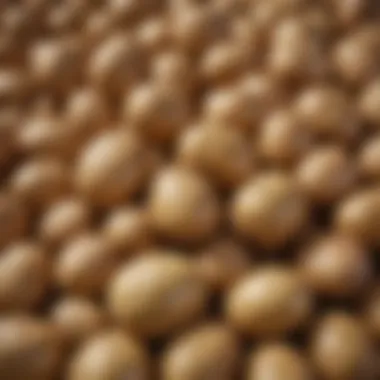
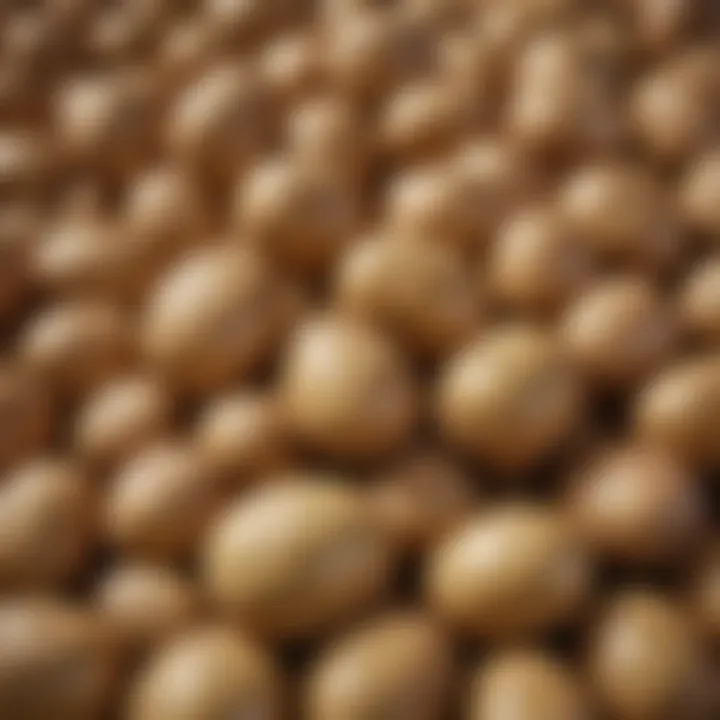
- Balance: Choose sauces that do not drown out the flavors of the dish.
- Simplicity: Sometimes less is more, particularly with flavors like olive oil and herbs.
Potato Pancakes
Preparation Techniques
Potato pancakes, also known as latkes, are a beloved dish for many. Preparation begins with grating potatoes and squeezing out excess moisture. Mix the grated potatoes with egg and flour, forming a batter. It's crucial to achieve the right consistency; too much moisture will lead to sogginess.
Key characteristics of preparation include:
- Texture: Getting the perfect crispy exterior is essential for enjoyment.
- Speed: This dish is quick to prepare, ideal for busy cooks.
Be aware that frying can lead to splatter, so caution is recommended during this process.
Toppings Ideas
The versatility of potato pancakes shines through in its myriad of toppings. Classic choices are sour cream and applesauce, yet variations like guacamole or smoked salmon have gained popularity. Highlighting this aspect of creativity contributes to individual tastes and preferences.
Benefits of diverse toppings include:
- Flavor enhancement: Toppings greatly influence the final taste.
- Customization: Diners can create their unique version based on their preferences.
However, be wary of ingredient overload, as it can detract from the dish's main components.
Serving Suggestions
Considering how to serve potato pancakes can elevate the experience. They can be plated as a main course with a side salad or served as an appetizer for a larger meal. This adaptability signifies their role as both comfort food and sophisticated fare.
Important points to consider include:
- Presentation matters: Arranging the pancakes attractively can enhance appeal.
- Portion size: Smaller sizes make for excellent finger food at gatherings.
Potato-Based Snacks
Chips and Crisps
Potato chips and crisps remain a popular option for snacking. The process includes thinly slicing potatoes and frying until they are perfectly crisp. The key characteristic of this snack is its crunchy texture, which keeps consumers coming back for more. This characteristic proves advantageous for busy people seeking quick bites.
Advantages include:
- Variety of flavors: Beyond traditional salt, options range from barbecue to gourmet truffle.
- Portability: Easy to enjoy on-the-go.
However, consumption should be moderated due to their high calory content.
Stuffed Potatoes
Stuffed potatoes also hold significant allure. Once baked, the inside is scooped out and mixed with various fillings. Cheddar cheese, bacon, and broccoli are common choices. This preparation showcases the versatility of potatoes once more.
Particular features of stuffed potatoes:
- Hearty nature: Offers a filling option for meals.
- Customization: Variations can suit different dietary needs, including vegetarian or gluten-free.
Be mindful that excessive filling may make them overly rich.
Dips and Spreads
Utilizing potatoes in dips and spreads showcases their adaptability further. Classic potato dips such as loaded baked potato dip combine creamy textures with savory and spicy elements. The benefit of using potatoes is the added creaminess and flavor, perfect for serving at gatherings.
Key aspects include:
- Simplicity in preparation: Most dips are straightforward to make.
- Crowd-pleaser: Potato dips often suit many tastes.
Yet, portion control is essential, as these dips can be quite hearty.
In summary, the innovative uses for potatoes extend beyond the familiar, encouraging culinary experimentation and creativity. Through these various preparations and serving suggestions, potatoes continue to hold a prominent position in diverse cuisine.
Culturally Diverse Potato Dishes
Culturally diverse potato dishes highlight the adaptability of potatoes in various cuisines around the globe. This section explores how different cultures incorporate potatoes into their traditional meals. The array of flavors and cooking methods not only broaden the palate but also demonstrate the food's versatility as a core ingredient. These dishes reflect cultural heritage and often serve as comfort food, providing a deeper understanding of culinary practices worldwide.
Indian Aloo Dishes
Aloo Gobi
Aloo Gobi is a famous Indian dish combining potatoes and cauliflower with spices. This dish represents the essence of Indian cuisine with its colorful ingredients and aromatic flavors. The primary characteristic of Aloo Gobi is its vibrant yellow color due to turmeric, making it visually appealing. It allows for modifications, adapting to various dietary preferences. The unique feature of this dish is its simplicity; it uses common spices and vegetables, making it accessible for many cooks. Serving this as part of a wider meal can ensure a balanced and flavorful spread.
Aloo Paratha
Aloo Paratha is an Indian stuffed bread, filled with spiced mashed potatoes. This dish holds a special place in Indian households and is often served for breakfast. The key characteristic of Aloo Paratha is its flaky, golden crust and the delicious filling that delivers comfort in every bite. This dish is beneficial for both filling and flavorful meals. A unique feature of Aloo Paratha is that it can be eaten with various accompaniments, such as yogurt or pickles. However, it may not be suitable for those avoiding gluten due to its wheat-based dough.
Aloo Tikki
Aloo Tikki consists of spiced potato patties that can be deep-fried or shallow-fried. This snack captures the essence of street food in India. The key characteristic of Aloo Tikki is its crispy exterior paired with a soft and flavorful inside. It is a popular choice for gatherings and parties due to its sharp taste and ease of preparation. A unique aspect is that it can be customized with fillings like peas or spices, enhancing its appeal. However, the frying process involves considerable oil, making it less healthy than baked alternatives.
Latin American Preparations
Papitas
Papitas, or small fried potato strips, are a staple in many Latin American countries. This dish offers a deliciously crispy texture that's hard to resist. The key characteristic of Papitas is their golden-brown color and addictive crunch, making them a favored side dish or snack. Their versatility makes them a beneficial addition to many meals as they pair well with various dips and sauces. However, it's relevant to note that they can be high in calories and unhealthy if consumed in excess.
Humitas
Humitas are a traditional dish made from corn and mashed potatoes, often wrapped in corn husks and steamed. This dish is significant in Andean cuisine and offers a unique blend of textures. The key characteristic of Humitas is their soft, slightly sweet flavor profile that appeals to both savory and sweet taste lovers. They can be made vegan, accommodating dietary considerations. However, preparation can be time-consuming, which may not suit all busy kitchens.
Causa
Causa is a Peruvian dish made with layered mashed potatoes, often filled with tuna or chicken. The key characteristic of Causa is its presentation, as it is often shaped into an eye-catching layered cake. This dish provides the benefit of visual appeal, making it a great option for gatherings. Its unique feature is the use of Peruvian yellow potatoes, contributing to its distinct flavor and creamy texture. However, sourcing some ingredients can be a challenge in certain regions, limiting accessibility.
European Delicacies
Spanish Tortilla
Spanish Tortilla is an essential part of Spanish cuisine, consisting of layers of potatoes and eggs. Its importance lies in its simplicity and rich flavor, capturing the essence of hearty meals. The key characteristic is its dense texture, which makes it suitable for tapas or main courses. The dish is beneficial as it can be prepared in advance and served hot or cold. The unique feature of Spanish Tortilla is its versatile nature, allowing for variations with additional ingredients like onions or peppers. However, its high egg content may not align with all diet preferences.
Colcannon
Colcannon is a traditional Irish dish, made from mashed potatoes with cabbage or kale. This dish serves as a comforting side, highlighting how potatoes can be combined with greens. The key characteristic of Colcannon is its creamy and hearty texture, which pairs well with meats. It embodies seasonal cooking, as the ingredients can vary with what is available. A disadvantage might be its calorie density, so moderation is encouraged.
Potato Dumplings
Potato Dumplings are popular in various European cuisines, known for their soft texture and savory fillings. The uniqueness lies in the dough made from potatoes, giving them a different consistency compared to flour-based dumplings. The primary characteristic is their ability to absorb flavors from sauces and broths. This dish is beneficial for versatility in fillings, offering an array of options. However, mastering the technique may present challenges for novice cooks.


Nutritional Profile of Potatoes
Understanding the nutritional profile of potatoes is essential for recognizing their value in daily diets. Potatoes are not just a filling side dish; they are a source of various nutrients that contribute to health and well-being. They provide essential macronutrients, vitamins, and minerals, making them a versatile food choice in various culinary creations.
Macronutrients
Potatoes mainly consist of carbohydrates, specifically starch, which makes them a great energy source. A medium-sized potato (about 150 grams) contains approximately 30 grams of carbohydrates. This accounts for a significant portion of daily energy needs. In addition to starch, potatoes provide a small amount of protein, generally around 2 grams. However, they are low in fat, containing less than 0.2 grams in a single medium potato. Incorporating potatoes into meals can help balance macronutrient intake when combined with proteins and healthy fats from other food sources.
Key macronutrient considerations include:
- Carbohydrates: Source of energy.
- Proteins: Supports muscle repair and growth.
- Fats: Very minimal, allowing flexibility in meal pairing.
Vitamins and Minerals
Potatoes are rich in several vitamins and minerals that support different body functions. Notably, they are an excellent source of Vitamin C, which is essential for immune system function and skin health. A medium potato can provide nearly 30% of the recommended daily intake of Vitamin C. Potatoes also contain B vitamins, including B6, which plays a vital role in energy metabolism and cognitive function.
In terms of mineral content, potatoes are a good source of potassium, which is crucial for heart health and muscle function. A medium potato can contain around 620 mg of potassium, contributing significantly to the daily requirement.
- Vitamin C: Boosts immunity.
- B6: Aids in energy metabolism.
- Potassium: Essential for heart and muscle health.
Health Benefits of Potatoes
The health benefits of potatoes are substantial, particularly when they are prepared in a healthy manner. Due to their high fiber content, especially in the skin, potatoes can aid digestive health. The fiber helps maintain regular bowel movements and supports a healthy gut microbiome. Additionally, the moderate glycemic index of potatoes allows for controlled blood sugar management, especially when consumed with proteins and fats.
Important Note: The way potatoes are cooked can greatly affect their health benefits. Frying, for example, adds excess calories and fats, while baking or steaming preserves their nutritional integrity.
Potential health benefits include:
- Digestive health: Supports a healthy gut.
- Blood sugar control: Moderate glycemic index allows balanced energy levels.
- Nutrient density: Provides multiple essential nutrients in low-calorie form.
Cooking Techniques for Potatoes
Cooking methods play a crucial role in the preparation of potatoes. Each technique can affect the final taste and texture of dishes, making it important to select the right method depending on the recipe. Potatoes can be transformed into something remarkable through various techniques, ranging from boiling to frying. Understanding these methods allows cooks to maximize flavor while ensuring that the nutritional integrity of potatoes is maintained. Here, we explore several fundamental cooking techniques that highlight the versatility of this staple food.
Boiling and Steaming
Boiling and steaming are basic methods that effectively cook potatoes while retaining their shape and nutrients. Boiling involves immersing potatoes in water until tender. This method is quick and suitable for dishes such as mashed potatoes or potato salad. Generally, it is advisable to cut potatoes into even pieces to enhance cooking consistency. Adding salt to the boiling water can improve flavor, but one should be cautious about oversalting.
Steaming involves cooking potatoes by placing them above boiling water, allowing steam to circulate. This technique is beneficial for preserving vitamins and minerals found in these vegetables. Steamed potatoes tend to have a firmer texture, which makes them ideal for salads or as a side dish.
Both techniques require careful timing to prevent overcooking, which can lead to a mushy texture. Consider using a fork to check doneness; it should pass through with slight resistance.
Roasting and Baking
Roasting and baking are methods that enhance the natural sweetness of potatoes. Roasting is performed by cooking potatoes at high temperatures, often with oil, which creates a crispy exterior. It is recommended to cut the potatoes into uniform sizes to ensure even cooking. Additionally, tossing them in a mix of herbs and spices can elevate the overall flavor.
Baking is slightly different, as it typically involves cooking whole potatoes at moderate heat. Baked potatoes can achieve a soft inside with a flaky skin. Wrapping them in foil is a common practice, but this can alter the texture. For the best results, do not cover them, allowing the potato skin to crisp. Both methods lead to nutty and rich flavors, making roasted or baked potatoes a favorite side dish for many.
Frying Techniques
Frying is among the most popular methods for preparing potatoes, resulting in a crunchy texture. This can be done through deep frying, pan-frying, or shallow frying. Deep frying involves immersing the potatoes in hot oil, creating classic dishes like French fries or crispy potato chips. It is essential to dry the potatoes before frying to avoid splatters and achieve desirable crispiness.
Pan-frying requires less oil and is often used for making potato cakes or hash browns. Managing heat is vital in this method; too high a temperature can burn the outside while leaving the inside undercooked.
Shallow frying, where potatoes are halfway submerged in oil, can yield delicious results with less oil consumption. Regardless of the frying method chosen, ensure to use oils with high smoke points, like vegetable or canola oil, for the best outcomes. Proper draining after frying is essential to remove excess oil.
Microwave Preparation
Microwaving is a quick and convenient way to cook potatoes, especially for busy cooks. This method involves placing potatoes directly in the microwave, which cooks them evenly in a fraction of the time required for boiling or baking. Simply pierce the skin to allow steam to escape and place a damp paper towel over the potatoes to keep them from drying out.
Depending on the size and type, microwaving potatoes usually takes about 5 to 10 minutes. It is important to turn them halfway through cooking for even texture. Microwaved potatoes can be used as a base for various dishes or mashed directly in the bowl.
Always test for doneness by piercing with a fork; if it goes in easily, they are ready.
Storing and Handling Potatoes
The manner in which potatoes are stored and handled is crucial to maintain their quality and longevity. Proper storage not only extends the shelf life of potatoes but also preserves their flavor, texture, and nutritional value. Understanding the best practices for choosing, storing, and managing potatoes is beneficial for anyone looking to maximize their culinary potential.
Choosing Quality Potatoes
When selecting potatoes, it is important to look for those that are firm, smooth, and free from blemishes. Avoid potatoes with soft spots, discoloration, or sprouting as these can indicate spoilage. Choosing the right variety for your needs will also enhance your cooking. For instance, starchy potatoes like Russets are ideal for baking and frying, while waxy varieties such as Red Bliss are preferred for salads and steaming. A simple yet effective guideline is to ensure potatoes have no signs of rot or excessive wrinkling before purchasing.
Proper Storage Conditions
Storing potatoes correctly requires a cool, dark, and well-ventilated space. A basement or a pantry with stable temperatures away from sunlight is usually the best. Temperature can significantly impact potatoes; ideally, they should be kept at around 45°F to 55°F. This prevents sprouting and slows down the decay process. If kept in too warm conditions, potatoes may soften or even begin to sprout. Storing potatoes in a paper bag or a basket allows for air circulation, which is important. Avoid plastic bags as they can trap moisture, leading to mold growth.
Managing Shelf Life
Understanding the shelf life of potatoes helps in planning meals better. Typically, if stored correctly, potatoes can last several weeks to a few months. Sprouted potatoes can still be used; just remove the sprouts before cooking. To prevent spoilage, check potatoes routinely and remove any that show signs of bad quality immediately. If you have a surplus, consider freezing cooked potatoes. This can be a useful method for long-term storage. However, raw potatoes do not freeze well, as the texture becomes mealy after thawing.
Proper care in storing and handling potatoes can make a significant difference in their taste and usage in the kitchen. It allows for better meal planning and reduces waste.
Implementing these practices will ensure that potatoes remain a versatile ingredient in your culinary endeavors.
The End
Reflecting on the vast culinary potentials of potatoes reveals their role as a fundamental ingredient across countless dishes. Potatoes, in all their forms, present an array of textures and flavors, making their versatility invaluable in the kitchen. From mashed potatoes to gnocchi, every preparation method offers unique opportunities to explore creativity.
Summary of Potato Versatility
The ability of potatoes to fit into various culinary contexts is extraordinary. Their adaptability lends itself well to diverse cuisines—from rustic European dishes to vibrant Latin American preparations. There are several varieties of potatoes, including Russet, Yukon Gold, and even fingerling potatoes, each bringing its own flavor and texture to the table. This variety means that home cooks can choose the right potato for every recipe, contributing to a more inviting dining experience.
Moreover, potatoes can be boiled, baked, fried, or steamed, which adds additional layers to their culinary potential. They can stand as the main ingredient or serve as a supporting element in more complex dishes. Their nutritional profile also enhances their appeal, providing essential vitamins and minerals that benefit overall health.
In essence, embracing potatoes as a staple food allows for endless culinary exploration. Whether you are preparing a comforting soup or an elaborate potato casserole, the possibilities are endless and exciting.
Encouragement for Culinary Exploration
As you venture into the realm of cooking with potatoes, consider their rich history and global usage. They are not just a simple vegetable; they are a bridge that connects diverse cultures through food. By trying new recipes, you can expand your palate and discover unique flavors that potatoes help create.
Start with basic preparations and gradually explore complex recipes. Engage with various techniques and ingredient pairings. Don't hesitate to experiment with spices and herbs that enhance the inherent flavor of the potato. Consider regional recipes from places like India, Peru, or Ireland, as they showcase the creativity and adaptability of this humble ingredient.







